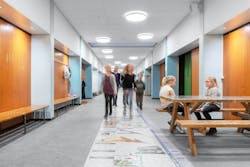Concentration at the Push of a Button
Albertslund, Denmark
So, for all the talk of color tuning, does it exist? It does, but sometimes you have to go far afield, say Denmark, and the Herstedlund Primary School. There, after the bell rings, fourth-year students take their seats for the first lesson—not so different than schools around the world. However, when teachers in these classrooms flick the switch, a very different experience follows. Light, more like daylight, floods the classroom, creating a more pleasant atmosphere. Thanks to Zumtobel’s Active Lighting system, teachers have a choice of four pre-programmed lighting “moods,” in line with the precepts of human-centric lighting. In this case, dimmable, and color-tunable ondaria 2 luminaires from the manufacturer deliver the desired learning environment. For example, after lunch, comes the inevitable afternoon lull. Yet now, teachers can use the tunable light to actively increase attention. In this scenario, as it might be in the early morning, stimulating cool-white light, notes the manufacturer, helps bring the classroom to life. But later, when a group exercise rounds off the school day, a scene with slightly subdued warm-white light provides a more relaxing ambience.
The scenarios were the result of research conducted at the University of Aalborg, which developed specific design criteria for the classroom lighting “moods.” Zumtobel worked with researchers to turn these concepts into reality. The project also uses the company’s lighting infrastructure and LITECOM lighting management system to collect data. The findings, to date, have now been brought together in a recently published study. In a nutshell, the lighting scenarios of the Active Light system, according to Zumtobel, have helped the school support learning, specifically in the form of helping teachers structure lessons while providing environmental versatility for staff and students throughout the day.
On average, teachers, thus far, change the lighting mood three times a day. Seasonal daylight differences and the spatial arrangement of the classrooms, which face in different directions, all have an influence on the lighting conditions, but it’s not a major challenge, according to Lybeck Casper, sales director of Zumtobel Group Denmark. “The Internet-enabled, and app-based system means that the four pre-programmed scenarios can be easily controlled by the teachers.”
The color settings and light intensity of all the luminaires in the classroom, he notes, are individually adjustable, and teachers can define their own settings.
